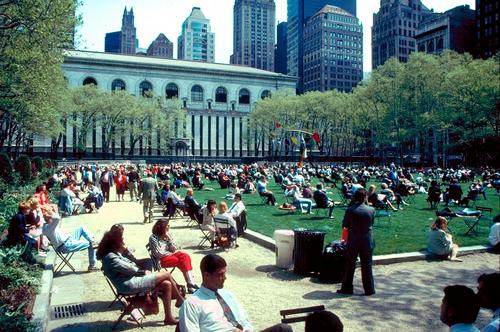A biweekly newsletter with public space news, resources, and opportunities.
A curated dispatch on all things public markets plus the latest announcements from the Market Cities Program.
New York, NY (1981)
Bryant Park's chief asset has always been its superb location next to the New York Public Library in Midtown Manhattan. In 1981, when PPS began its work there, thousands of people walked along the park's edges every day--and just as many looked down on it from nearby offices buildings--but hardly anyone went inside. It was easy to see why. PPS once observed nine separate groups of people dealing drugs in the park and at its entrances. The park was poorly maintained. Overall it seemed like a very threatening place.

How could such a well-situated park fail so miserably? Several design problems explained its downfall. First, the whole park was three and a half feet above the adjoining sidewalks (to accommodate the library stacks underneath). Hedges and a wrought iron fence on top of this wall made the interior even more invisible from the sidewalk. The park's narrow, constricted entrances made people wary of coming inside because they could not visually check it out in advance. Once inside, the heavy canopy of trees and abundance of hedges made it hard for visitors to even see one part of the park from another. But the main problem was that even the brave who ventured inside for purposes other than buying drugs found little to do there!
We interviewed park visitors and nearby office workers as well as the drug dealers themselves...
Fortunately, some positive changes were underway at that time. The Municipal Arts Society added bookstalls and a small café in an attempt to boost legitimate use of the park, and these efforts worked. But even as more people ventured into the park during the lunchtime peak, the dealing increased as well. It was clear that it would take more than a redesign to draw everyday citizens back to Bryant Park.
We interviewed park visitors and nearby office workers as well as the drug dealers themselves for our report, "Bryant Park, Intimidation or Recreation?", which offered a series of specific objectives, recommendations, and perspective drawings that illustrated how different areas in the park could be improved to support public activities. To attract those who typically avoided the park, such as women and people over 40, PPS proposed opening up the entrances and removing the visual barriers along the park's periphery. Combined with new amenities like 1000 movable chairs (an idea inspired by Holly Whyte), food and beverage kiosks, a stand for buying theater tickets, and a restaurant with outdoor table service--all located at the prime spots where the drug dealers had positioned themselves--these improvements spawned more public activity, crowding out the dealers and other undesirable uses.

Implementation of PPS's recommendations has made Bryant Park one of the most popular and comfortable big city parks in the country. Key to its success was the founder of the Bryant Park Restoration Corporation, Dan Biederman, whose leadership was critical at a time when no one thought the park could be improved. BPRC, which manages the park, has continued to develop and implement innovative ideas to attract people during all seasons. The park's success has spurred a district-wide revival: Rental activity around the park increased by 60 percent after its reclamation and the park is widely considered the prime public asset in booming Midtown Manhattan.
We came away from our work on Bryant Park with a newfound appreciation for managing public spaces in a hands-on, creative way. Today we say that at least 80% of a park's success is due to good management. For cities seeking to tap the economic benefits of great public parks, the importance of management remains the most significant lesson to draw from Bryant Park.
The rich text element allows you to create and format headings, paragraphs, blockquotes, images, and video all in one place instead of having to add and format them individually. Just double-click and easily create content.
The rich text element allows you to create and format headings, paragraphs, blockquotes, images, and video all in one place instead of having to add and format them individually. Just double-click and easily create content.
Body Text Body Link
The rich text element allows you to create and format headings, paragraphs, blockquotes, images, and video all in one place instead of having to add and format them individually. Just double-click and easily create content.
Here is some highlighted text from the article.




Headings, paragraphs, blockquotes, figures, images, and figure captions can all be styled after a class is added to the rich text element using the "When inside of" nested selector system.
Headings, paragraphs, blockquotes, figures, images, and figure captions can all be styled after a class is added to the rich text element using the "When inside of" nested selector system.
Headings, paragraphs, blockquotes, figures, images, and figure captions can all be styled after a class is added to the rich text element using the "When inside of" nested selector system.